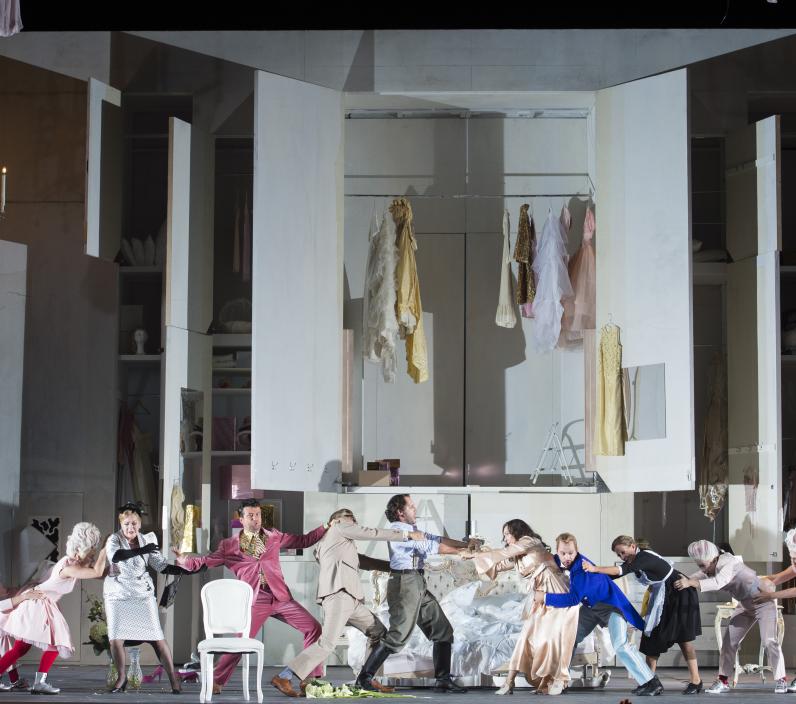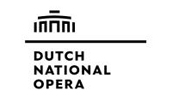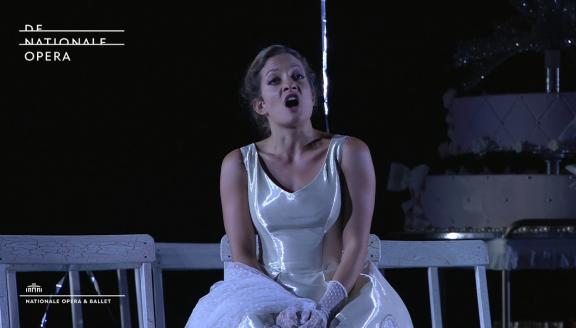

One very confusing day for Figaro and companions; one very entertaining night on OperaVision.
Cast
Count Almaviva | Stéphane Degout |
|---|---|
Countess Almaviva | Eleonora Buratto |
Susanna | Christiane Karg |
Figaro | Alex Esposito |
Cherubino | Marianne Crebassa |
Marcellina | Katherine Goeldner |
Bartolo | Umberto Chiummo |
Basilio | Krystian Adam |
Don Curzio | Jeroen de Vaal |
Barbarina | Louise Kemeny |
Antonio | Matteo Peirone |
Chorus | Chorus of the Dutch National Opera |
Orchestra | Netherlands Chamber Orchestra |
| ... | |
Music | Wolfgang Amadeus Mozart |
|---|---|
Conductor | Ivor Bolton |
Director | David Bösch |
Sets | Patrick Bannwart |
Lighting | Olaf Winter |
Costumes | Meentje Nielsen |
Text | Lorenzo da Ponte |
Dramatisation | Klaus Bertisch |
| ... | |
Video
The story
Act 1. It is the day of Figaro’s marriage to Susanna, maid to the Countess. Figaro, valet to the Count, is assessing the bedroom offered to him by his employer; it conveniently adjoins both the Count’s and the Countess’s apartments. Susanna points out that the room will also be convenient when the Count chooses to reinstate the ‘Droit de Seigneur’, a feudal practice in which a local Count can ‘deflower the bride;’ a practice that he has recently abolished. Figaro determines to outwit his master (‘Se vuol ballare,’ If you want to dance, I’ll play the tune).
But Figaro owes money to Marcellina, and has promised to marry her if he does not manage to repay her. He has also raised the ire of Dr. Bartolo, the Countess’s former guardian, for his role in helping bring about the Count’s marriage to the Countess. To complicate matters further, the young page Cherubino wants Susanna to intercede on his behalf with the Count, who has dismissed him from the castle after catching him alone with Antonio’s daughter, Barbarina.
Suddenly the Count shows up, causing disarray. Cherubino hides and hears the Count’s overtures to Susanna. The Count in turn hides, and overhears Basilio, the music master, making insinuations about Cherubino and the Countess. The Count emerges, discovers the unfortunate page, and sends him to rejoin his regiment.
Act 2 begins with a weeping Countess, lamenting the loss of the Count’s love (‘Porgi amor’). Figaro reveals his plan to outwit the Count: he has sent him an anonymous letter implying that the Countess has a lover. Susanna points out that Marcellina can still invoke the debt and stop the wedding, and a second plan is hatched. Susanna will agree to meet the Count in the garden, but Cherubino will go disguised in her place. Figaro instructs the women to dress Cherubino appropriately.
The page flirts with the ladies by singing his latest composition (‘Voi che sapete’). When he is half undressed, the Count arrives. Having received Figaro’s letter, he is in a jealous rage. Cherubino, hidden in the closet, knocks over a chair. The Countess, in a panic, pretends that the noise is Susanna, but refuses to unlock the door; meanwhile, Susanna rescues Cherubino, who escapes out of the window. Susanna locks herself in the closet.
The Countess attempts to explain to her husband the presence of Cherubino in her closet. She is as surprised as the Count when it is Susanna who emerges. The two women pretend that the whole episode was a trick to provoke the Count into better treatment of his wife. They confess that the letter was written by Figaro, who then joins them, unaware of the women’s revelations to the Count. When Bartolo, Basilio and Marcellina arrive with a law suit to force Figaro’s marriage to Marcellina, the Count is triumphant.
The Countess and Susanna open the third act with a plan to disrupt the Count’s amorous intentions. Susanna will agree to meet the Count that evening in the garden, but the Countess will go in her place, disguised as her maid.
On the advice of his legal consultant, Don Curzio, the Count insists that Figaro pay Marcellina at once or marry her. Figaro is saved by the timely revelation that he is the long-lost son of Marcellina and Bartolo; everyone but the Count and Don Curzio embraces their new relations.
Finally the wedding celebrations of Figaro and Susanna begin. Cherubino is unmasked among the bridesmaids, but Barbarina shames the Count into allowing him to stay at the castle. Susanna passes the Count the letter dictated by the Countess, confirming her evening rendezvous with him under the pine trees.
In the garden everybody is waiting: the Count and Figaro for Susanna; the Countess for the Count; Bartolo and Basilio to witness the revival of the ‘Droit de Seigneur.’ Figaro rails against the faithlessness of Susanna (‘Aprite un po’ quegli occhi’); while she looks forward to the conclusion of her plans (‘Deh vieni, non tardar’).
The appearance of Cherubino is potentially disastrous, but the Count arrives and woos ‘Susanna,’ in fact his wife. The jealous Figaro is then confronted by Susanna, disguised as the Countess, but he recognises his bride and they are reconciled – witnessed by the Count, who believes he sees his wife in the arms of his valet. He denounces her; the real Countess unmasks herself and forgives her husband. The day ends in celebration.
Insights
‘This was already the revolution,’ concluded Napoleon when he was asked about Beaumarchais’s comedy The Marriage of Figaro. In his play, Beaumarchais ridiculed the French noblesse. The staging of Figaro was promptly prohibited. Nevertheless – or maybe therefore – Mozart chose to make it the source of his most famous opera buffa.
The plot of Le Nozze di Figaro is set some years after the actions of The Barber of Seville that later was adapted into an opera by Rossini in 1816. Count Almaviva is making advances to Susanna, his wife’s maid who is madly in love with his servant Figaro. The Count and Doctor Bartolo plot to force Figaro to keep an old wedding promise. But at the same time, the Countess seeks to avenge her spouse’s infidelity and helps Figaro and Susanna to pursue their happiness.
German director David Bösch has made a name for himself in numerous German opera houses and theatres. He staged productions at the Frankfurt opera, at the Burgtheater in Vienna and, most recently, a Meistersinger von Nürnberg at the Bavarian State Opera. This staging of Mozart’s famous opera buffa is his first in Amsterdam.
Baritone Stéphane Degout sings the role of the lecherous Count Almaviva, Eleonora Buratto performs as the Countess. Figaro is portrayed by Alex Esposito who has sung roles of the Mozartian repertoire on some of the most famous stages internationally. Christiane Karg makes her debut at Dutch National Opera in the role of Susanna. The Netherlands Chamber Orchestra plays under the baton of Ivor Bolton.


